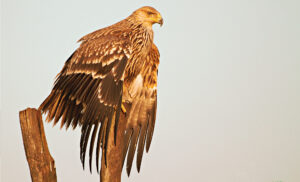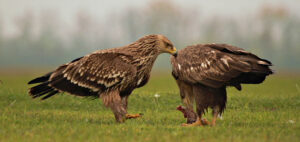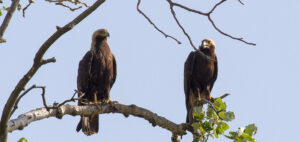Third International Scientific and Practical Conference “Eagles of the Palearctic: Study and Conservation”
Raptors Conservation. Suppl. 2. Proceedings of Conferences
Status of the Eastern Imperial Eagle in Hungary Between 2019 and 2023
Horvath M. (MME BirdLife Hungary, Budapest, Hungary)
Juhász T. (Hortobagy National Park Directorate, Debrecen, Hungary)
Fatér I., Deák G., Árvay M. (MME BirdLife Hungary, Budapest, Hungary)
Pásztory-Kovács S. (University of Veterinary Medicine, Budapest, Hungary)
Contact:
Márton Horváth horvath.marton@mme.hu
Tibor Juhász juhaszpoktibor@gmail.com
Imre Fatér fater.imre@mme.hu
Gábor Deák deak.gabor@mme.hu
Márton Árvay arvay.marton@mme.hu
Szilvia Pásztory-Kovács koviszilvi@gmail.com
Recommended citation: Horváth M., Juhász T., Fatér I., Deák G., Árvay M., Pásztory-Kovács S. Status of the Eastern Imperial Eagle in Hungary Between 2019 and 2023. – Raptors Conservation. 2023. S2: 281–283. DOI: 10.19074/1814-8654-2023-2-281-283 URL: http://rrrcn.ru/en/archives/35082
The Hungarian population of the Eastern Imperial Eagle (Aquila heliacais closely monitored by MME BirdLife Hungary and the ranger service of the Hungarian national park directorates since 1980. The population is slowly, but continuously increasing during the last four decades and the average population growth rate is 11% and the number of estimated nesting population has increased from 230–240 pairs (2018) to 400–450 (2023).
The distribution area is also still expanding to the south and the species colonised new areas especially in Bács-Kiskun, Csongrád and Győr-Moson-Sopron counties, but even spread to Serbia and Romania. The breeding density also increased in the core areas of the breeding range especially in Heves, Jász-Nagykun-Szolnok and Békés counties, which hold the most important stronghold of the species in the Pannonian basin. Besides, the average breeding success also increased to 1.54 fledgling/breeding pair and 1.91 fledgling/successful pair by 2022. The prevalence of raptor poisoning incidents decreased and were kept in a relatively low level between 2014–2022 thanks to specific and complex conservation measures with the help of the EU’s LIFE Nature programme (HELICON and PannonEagle LIFE projects). Due to the significant increase of the population and the limited capacity of the working group, the national monitoring protocol has been changed in 2023. The key parameters of the national population (i.e. no. of nesting pairs, no. of chicks) is still monitored by the ranger service of the Hungarian national park directorates. On the other hand, the complex monitoring program of MME BirdLife Hungary, which is gathering detailed data on breeding performance (including ringing and drone surveillance, diet and genetic analyses) is focusing only on selected sample areas, which recently covers 50% of the population (ca. 200 pairs).



